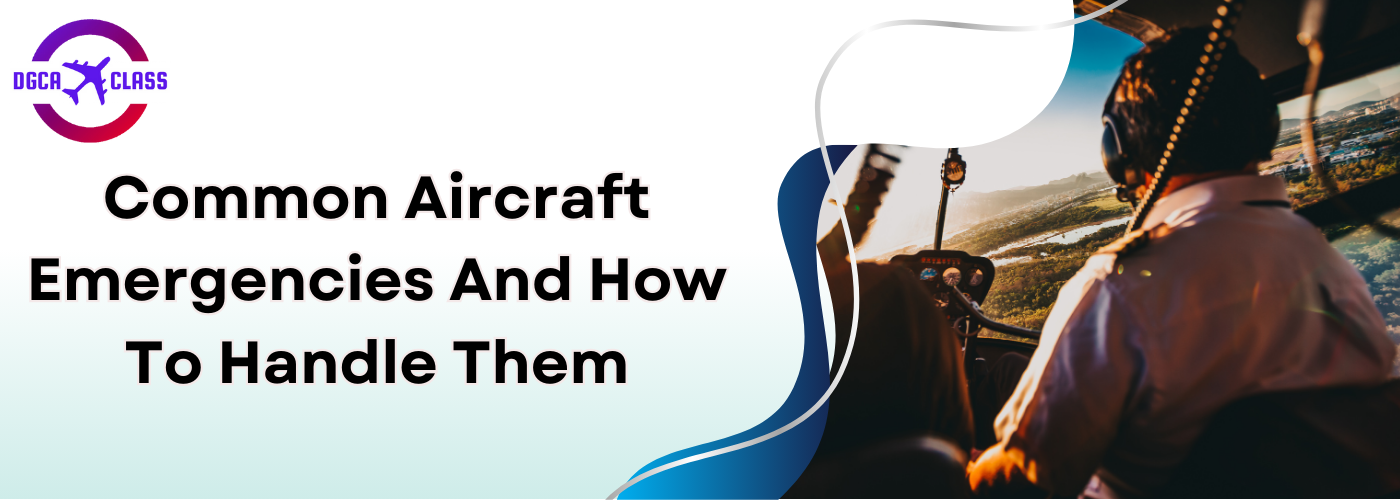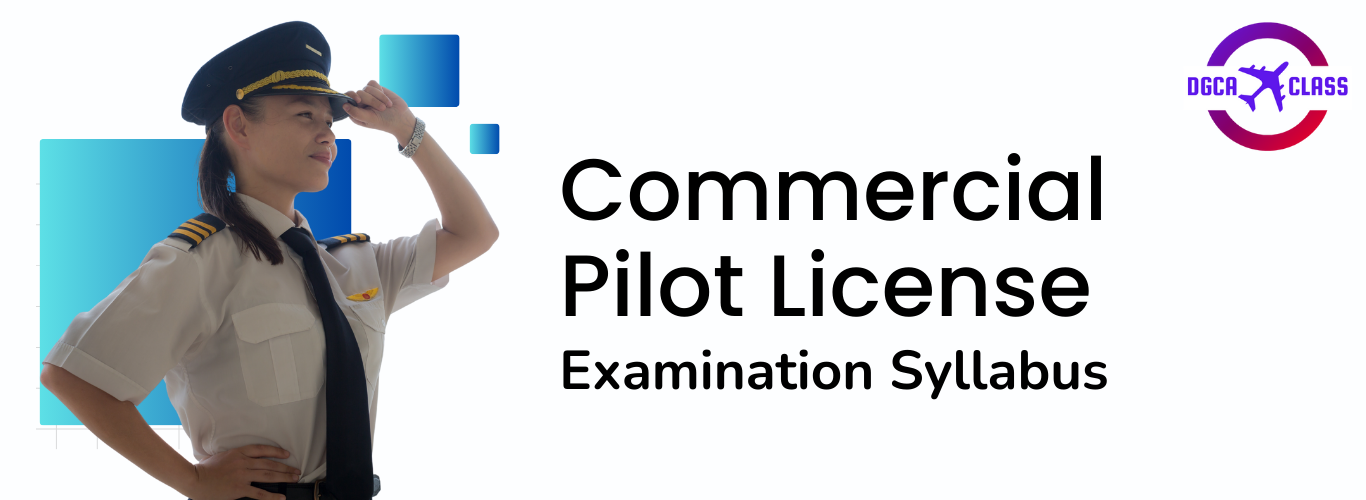Flying an aircraft involves managing a range of potential emergencies that can arise at any time. Pilots are rigorously trained to handle such situations, ensuring the safety of passengers and crew. Understanding these emergencies and the appropriate responses is crucial. This blog explores common aircraft emergencies and provides guidance on how to handle them.
Engine failures can occur due to mechanical issues, fuel starvation, or environmental factors like bird strikes.
| Steps |
Description |
| 1.Maintain Control |
Aviate, navigate, and communicate. Focus on flying the aircraft. |
| 2.Best Glide Speed |
Establish and maintain the best glide speed to maximize distance and time. |
| 3.Identify Landing Site |
Quickly identify and head towards a suitable emergency landing site. |
| 4.Troubleshoot |
Attempt to restart the engine by checking fuel levels, switching tanks, and ensuring proper mixture and ignition settings. |
| 5.Declare Emergency |
Communicate your situation to ATC, providing your position, altitude, and intentions. |
| 6.Prepare for Landing |
Execute a forced landing, securing the cabin and briefing passengers on emergency procedures. |
Depressurization can result from structural damage, window failures, or malfunctioning pressurization systems.
| Steps |
Description |
| 1.Don Oxygen Masks |
Immediately put on oxygen masks and ensure passengers do the same. |
| 2.Descend |
Perform an emergency descent to a safe altitude where breathable oxygen levels are sufficient. |
| 3.Communicate |
Inform ATC about the depressurization and descent. |
| 4.Check for Damage |
Once stabilized, assess the aircraft for structural damage or other issues. |
| 5.Land |
Divert to the nearest suitable airport and land as soon as possible. |
Hydraulic failures can stem from leaks, pump failures, or contamination in the hydraulic fluid.
| Steps |
Description |
| 1.Assess the Situation |
Determine which systems are affected (e.g., brakes, landing gear, flight controls). |
| 2.Use Backup Systems |
Engage any backup hydraulic or manual systems if available. |
| 3.Adjust Flight Plan |
Consider diverting to an airport with longer runways and better emergency services. |
| 4.Communicate |
Inform ATC of the situation and your intentions. |
| 5.Prepare for Landing |
Use alternate methods for extending landing gear and prepare for a potentially difficult landing. |
Electrical failures can occur due to short circuits, alternator failures, or battery issues.
| Steps |
Description |
| 1.Assess and Isolate |
Identify and isolate the faulty component by turning off nonessential electrical equipment. |
| 2.Use Backup Power |
Utilize any backup batteries or alternators available. |
| 3.Navigate and Communicate |
Use handheld radios and backup navigation tools if necessary. |
| 4.Prepare for Manual Operation |
Be prepared to manually operate landing gear and flaps. |
| 5.Land as Soon as Possible |
Communicate with ATC and land at the nearest suitable airport. |
Fuel starvation can be caused by fuel mismanagement, leaks, or blockages.
| Steps |
Description |
| 1.Switch Tanks |
If one tank runs dry, switch to another tank. |
| 2.Check Fuel Pumps |
Ensure fuel pumps are operating correctly. |
| 3.Monitor Consumption |
Track fuel levels and consumption rates closely. |
| 4.Plan for Diversion |
Be prepared to divert to the nearest airport if fuel levels become critically low. |
| 5.Communicate |
Inform ATC of your fuel situation and intentions. |
Icing can occur in flight when flying through clouds or precipitation in freezing temperatures.
| Steps |
Description |
| 1.Switch Tanks |
If one tank runs dry, switch to another tank. |
| 2.Check Fuel Pumps |
Ensure fuel pumps are operating correctly. |
| 3.Monitor Consumption |
Track fuel levels and consumption rates closely. |
| 4.Plan for Diversion |
Be prepared to divert to the nearest airport if fuel levels become critically low. |
| 5.Communicate |
Inform ATC of your fuel situation and intentions. |
Bird strikes are a common hazard, especially during takeoff and landing phases near airports.
| Steps |
Description |
| 1.Maintain Control |
Stay calm and maintain control of the aircraft. |
| 2.Assess Damage |
Evaluate any damage to engines, wings, or other components. |
| 3.Communicate |
Inform ATC about the strike and your intentions. |
| 4.Land |
If the strike occurs during takeoff, consider aborting the takeoff. If in flight, prepare for an emergency landing if necessary. |
| 5.Report Incident |
Follow procedures to report the bird strike to relevant authorities. |
Medical emergencies can occur due to passenger or crew health issues, such as heart attacks, strokes, or severe allergic reactions.
| Steps |
Description |
| 1.Assess the Situation |
Determine the severity of the medical issue. |
| 2.Provide First Aid |
Administer first aid and use onboard medical kits. |
| 3.Seek Assistance |
Ask if there are any medical professionals onboard. |
| 4.Communicate |
Inform ATC of the medical emergency and request assistance. |
| 5.Divert |
Consider diverting to the nearest suitable airport for medical help. |
Flight control malfunctions can arise from mechanical failures, hydraulic issues, or control system faults.
| Steps |
Description |
| 1.Assess the Situation |
Determine which control surfaces are affected. |
| 2.Use Backup Systems |
Engage any backup or manual control systems if available. |
| 3.Adjust Flight Plan |
Plan for a landing at an airport with good emergency facilities. |
| 4.Communicate |
Inform ATC about the malfunction and your intentions. |
| 5.Prepare for Landing |
Execute the landing with any available control surfaces and prepare for potential challenges on the approach. |
Landing gear malfunctions can be due to hydraulic failures, mechanical issues, or electrical faults.
| Steps |
Description |
| 1.Attempt Manual Extension |
Use emergency procedures to manually extend the landing gear. |
| 2.Verify Position |
Use visual checks or tower flybys to confirm gear position. |
| 3.Communicate |
Inform ATC about the situation and your intentions. |
| 4.Prepare for Landing |
Plan for a landing with the available gear configuration and brief passengers on emergency procedures. |
| 5.Brace for Impact |
Ensure the cabin is secured and passengers are prepared for a potential gearup landing. |
Instrument failures can result from electrical issues, sensor malfunctions, or software faults.
| Steps |
Description |
| 1.Use Backup Instruments |
Rely on backup instruments and crosscheck with other available data. |
| 2.Revert to Basic Navigation |
Use dead reckoning and visual landmarks if necessary. |
| 3.Communicate |
Inform ATC about the instrument failure and request assistance. |
| 4.Prepare for Manual Operation |
Prepared to fly manually without relying on affected instruments. |
| 5.Land as Soon as Possible |
Plan for a landing at the nearest suitable airport. |
Fires can start due to electrical issues, engine problems, or external factors like lightning strikes.
| Steps |
Description |
| 1.Identify the Source |
Determine whether the fire is electrical, enginerelated, or otherwise. |
| 2.Use Extinguishers |
Use onboard fire extinguishers to combat the fire. |
| 3.Isolate the Fire |
Turn off affected systems or components. For an electrical fire, turn off the master switch. |
| 4.Emergency Descent |
If necessary, initiate an emergency descent to land as soon as possible. |
| 5.Communicate |
Inform ATC of the situation and your intentions. |
| 6.Prepare for Evacuation |
Inform ATC of the situation and your intentions. |
Handling aircraft emergencies requires a combination of technical knowledge, calm decision-making, and adherence to established procedures. Pilots must be thoroughly trained and prepared to manage these situations to ensure the safety of all onboard. By understanding the common emergencies outlined in this blog and applying the appropriate responses, pilots can effectively navigate these challenging scenarios.
Maintain control of the aircraft, establish best glide speed, identify a suitable landing site, attempt engine restart procedures, communicate with air traffic control (ATC), and prepare for a forced landing.
Identify the source of the fire, use onboard fire extinguishers if available, isolate the fire by shutting off affected systems, consider an emergency descent if necessary, inform ATC, and prepare for a potential emergency landing.
Don oxygen masks immediately, perform an emergency descent to a safe altitude, communicate with ATC about the situation, assess for damage, and divert to the nearest suitable airport for landing.
Assess the affected systems, use backup hydraulic or manual systems if available, consider diverting to an airport with longer runways, communicate with ATC, and prepare for a potentially challenging landing.
Assess and isolate the faulty component, utilize backup power sources, navigate and communicate using handheld radios if necessary, and land at the nearest suitable airport.
Switch to alternate fuel tanks, check fuel pumps, monitor fuel consumption closely, plan for diversion to the nearest airport, and communicate fuel situation with ATC.
Activate antiice systems, change altitude to exit icing conditions, maintain appropriate speed, monitor ice accumulation, and inform ATC about icing conditions.
Maintain control of the aircraft, assess damage, communicate with ATC, consider aborting takeoff or preparing for an emergency landing, and report the incident to relevant authorities.
Assess the severity of the medical issue, provide first aid, seek assistance from medical professionals onboard, communicate with ATC, and consider diverting to the nearest suitable airport for medical assistance.
Assess affected control surfaces, engage backup systems if available, plan for landing at an airport with good emergency facilities, communicate with ATC, and prepare for landing challenges.
Attempt manual gear extension procedures, verify gear position, communicate with ATC, prepare for landing with available gear configuration, and ensure passengers are briefed for a potential gear-up landing
Use backup instruments, revert to basic navigation methods, communicate with ATC about the failure, prepare for manual operation, and plan for a landing at the nearest suitable airport.
Regularly monitor fuel levels and consumption rates, switch tanks when necessary, conduct thorough preflight inspections, and be prepared to divert to the nearest airport if fuel levels become critically low.
Pilots undergo rigorous training that includes emergency procedures, simulator sessions, and recurrent training to prepare for handling various emergencies effectively.
Pilots are trained to stay calm and focused through simulation training, stress management techniques, and experience gained from handling emergencies in training scenarios.
Yes, aircraft manufacturers provide emergency checklist procedures tailored to specific emergencies, which pilots are trained to follow during training and actual emergencies.
Pilots have access to simulator training, recurrent training programs, emergency procedures manuals, and online resources provided by aviation authorities and organizations.
Pilots use designated emergency frequencies to communicate with ATC, providing necessary information about the emergency situation and their intentions.
Onboard fires can be caused by electrical faults, engine malfunctions, fuel leaks, or external factors such as lightning strikes.
Passengers should remain calm, follow crew instructions, fasten seat belts, adopt brace positions if instructed, and cooperate with crew during evacuation procedures.








